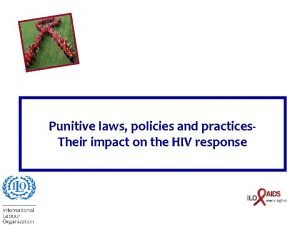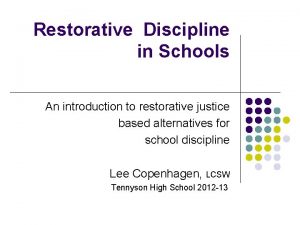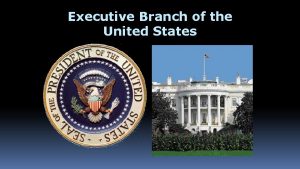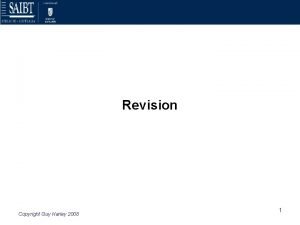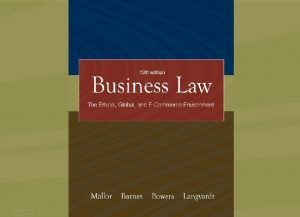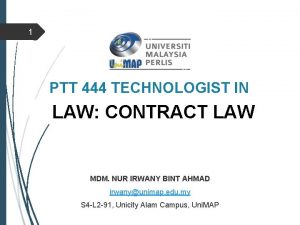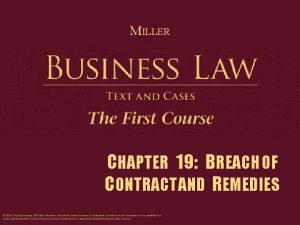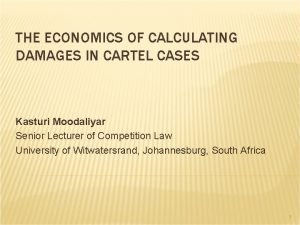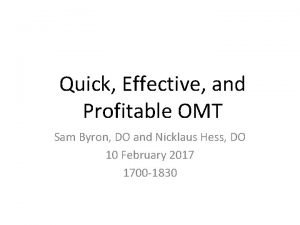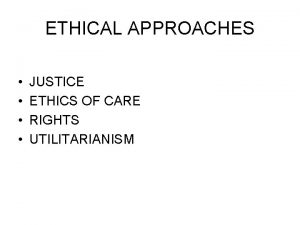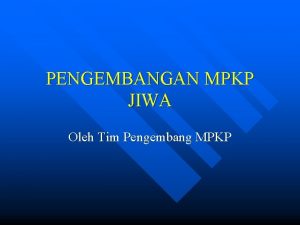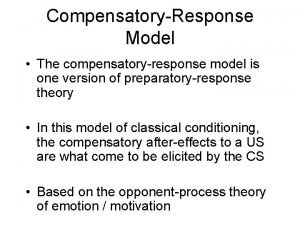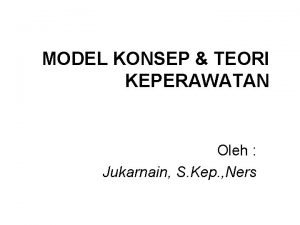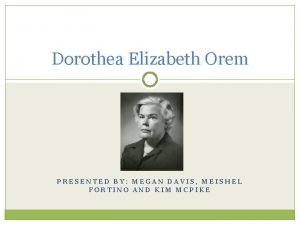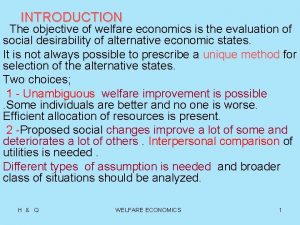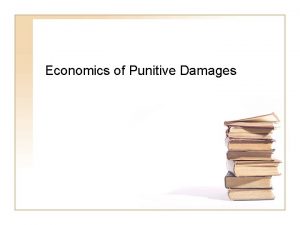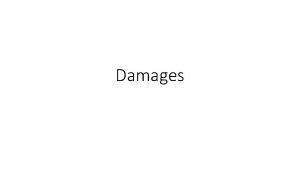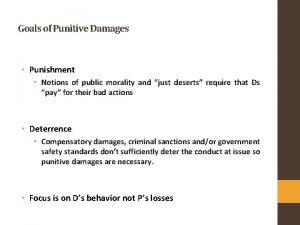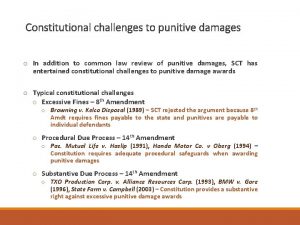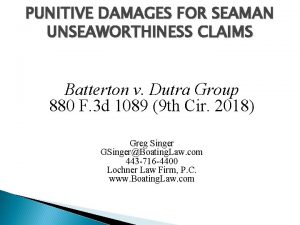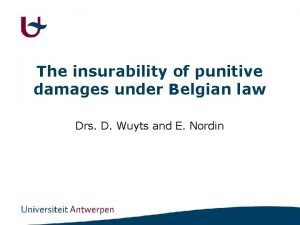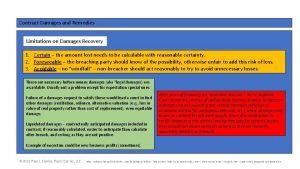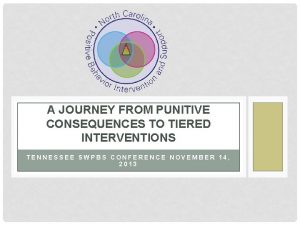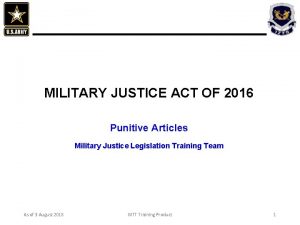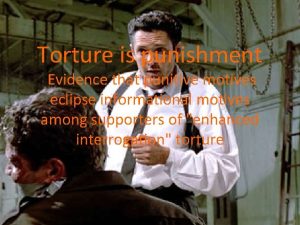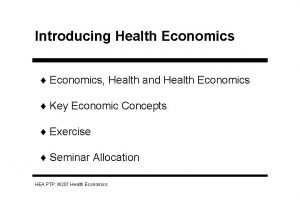Economics of Punitive Damages Compensatory vs Punitive Damages






























- Slides: 30

Economics of Punitive Damages

Compensatory vs. Punitive Damages Compensatory damages are meant to return the victim to the pre-injury state • Punitive damages are meant to deter the tortfeasor from injuring others •

Two questions posed by Cooter & Ulen Under what conditions should punitive damages to be awarded? • How should the amount of punitive damages determined? •

General guidelines for punitive damages Punitive damages are awarded when the defendant’s behavior is malicious, oppressive, gross, willful and wonton, or fraudulent. • Punitive damages should • • Bear a reasonable relationship to compensatory damages • Depend on the defendant’s ability to pay • There are no precise legal rule for calculating punitive damages

Finnish Traffic Fines HELSINKI, Finland -- Jaako Rytsola, a 27 -year-old Finnish Internet entrepreneur and newspaper columnist, was cruising in his BMW one recent evening. "The road was wide and I was feeling good, " he later wrote. "It's nice to be driving when there's no one in sight. " But this road wasn't empty; a radar-equipped police car was clocking his speed. The officer pulled over Mr. Rytsola's car and issued him a speeding ticket for driving 43 miles an hour in a 25 -mile-an-hour zone. The fine: $71, 400. Link • If we assume the marginal utility of a dollar declines, should the fine be positively related to income? •

Finnish Fine calculation The equations start with a motorist's net monthly income. The figure comes into play whenever a driver is caught going at least 12 miles an hour over the posted limit (below that, the fine is a fixed amount, ranging from $63 to $110). To begin, the driver's monthly net income is reduced by 1, 500 Finnish marks ($235) and that total is divided by 60. This figure is supposed to represent a person's daily disposable income. Then, for every dependent, such as a child or nonworking spouse, 15 marks is subtracted. But as many as 20 marks may be added depending on the value of the driver's other assets, including real estate. • The final figure, called a day fine, is then multiplied by a number ranging between one and 120, representing the severity of the violation as determined by the traffic officer. For example, a person driving 20 miles an hour over the limit on a highway in good weather might be assessed 12 day fines. •

Economic view of punitive damages There is no need for punitive damages if the tort system is perfect • Compensatory damages will internalize all external social costs. • • All victims receive perfect compensation

Possible imperfections in the tort system Not every victim brings suit • Not every victim can prove damages • Perfect damages are not always awarded or possible. • Result • • Compensatory damages are less than the total social cost of injury

Suppose the injurer receives a net benefit from the costs imposed on others? • Profit maximizing manufacturer may choose less than optimal precaution • • Under strict liability this will lead to less than optimal precaution Less of a concern under negligence Enforcement error can be corrected by offsetting compensatory damages with punitive damages • Compensatory damages are not enough to deter inefficient risky behavior •

Cooter and Ulen Example • • • A manufacturer of a fuel additive for automobile engines is keeping a careful eye on costs. He can set quality control at a high or a low level. High-level quality control costs $9, 000 per year and guarantees that the fuel additive is pure and never causes damage to automobile engines. Low-level quality control is costless (thus saving $9, 000) but results in some batches of the fuel additive’s being flawed. A few of the cars using the flawed batch will be harmed; specifically, the expected damage to cars is $10, 000 per year ($1000 in expected damages to each of 10 cars). Strict liability with perfect compensation would produce efficient care. (High level quality control)

Cooter and Ulen Example • Suppose only half the consumers sue for damages • Expected liability is only $5, 000 • The company will opt for low level quality care

Economic model of punitive damages x = precaution p = probability of harm A = harm caused by the accident L = injurer’s liability m = punitive multiple e = enforcement error

Economic model of punitive damages Social optimum Defendant’s optimum With enforcement error Liability is only a fraction of the actual harm

Economic model of punitive damages Therefore Result is too little care This can be adjusted by using a multiple m To correct the error set If e =. 1 then m = 10 L should be equal to Am

Related problems Correctly estimating error, e • • • What percent of injured parties did not collect damages? What jurisdictions are to be considered? Correctly estimating optimal level of precaution under negligence rules Possibility of multiple punitive damage awards Social policy determined by a small group of individuals who do not have the ability to engage in independent fact finding • • Judge serves as gatekeeper Punitive damages have an impact on the incentive to bring suit • • • The damages do not need to go to the plaintiff for optimal deterrence Represents a windfall gain for the plaintiff

BMW v Ira Gore (Ala. 1996) Nationwide policy that if the repair costs did not exceed 3 percent of the suggested retail price the car was sold as new • The customer drove the car for approximately 9 months without noticing any flaws • When he took the car in for detailing the shop detected evidence that the car had been repainted and informed Gore • Gore’s car had been partially repainted by BMW at a cost of $ 601. 37, which was about 1. 5 percent of the car's suggested retail price •

BMW v Ira Gore (1996) • At trial before a jury, the customer claimed that • His actual damages were $ 4, 000, in that the value of one of the manufacturer's repainted cars was approximately 10 percent less than the value of a new car that had not been damaged and repaired; and • A punitive damages award of $ 4 million would provide an appropriate penalty, using the $4, 000 actual damages estimate, in that since 1983, the manufacturer had sold as new 983 cars which had been repainted at a cost of more than $ 300 per vehicle, including 14 in Alabama. $4, 000 x 1, 000 cars = $4 million

BMW v Ira Gore (1996) The jury--based on its determination that the nationwide policy of nondisclosure constituted gross, oppressive, or malicious fraud for purposes of Alabama statutes which authorized punitive damages The jury returned a verdict which awarded the customer $ 4, 000 in compensatory damages and $4 million in punitive damages.

How would BMW change? • It would warn consumers of any pre-sale repairs • Buyers might expect some price reduction, but probably less than $4, 000 • Cost of price reduction would be passed on to all buyers

BMW v Ira Gore (1996) • The Supreme Court of Alabama expressed the view that • A jury could not use the number of similar acts that a defendant had committed in other jurisdictions as a multiplier when determining the dollar amount of a punitive damages award, • A constitutionally reasonable punitive damages award in the case at hand was $2 million • No statement on how they arrived at the $2 million. There were only 14 cars similar cars in Alabama.

BMW v Ira Gore (1996) The United States Supreme Court reversed and remanded. • The $ 2 million punitive damages award was grossly excessive and hence exceeded the limit under the due process clause of the Federal Constitution's Fourteenth Amendment, in that • There were none of the aggravating factors associated with particularly reprehensible conduct was present. • Harm was purely economic in nature. • BMW was not a recidivist who knew that what it was doing was wrong. • There were no false statements made by BMW. • BMW did not violate any state law requiring disclosure. • The jury cannot punish BMW for actions that did not harm Alabama residents. • May not impose sanctions to deter conduct that is legal in other jurisdictions. • The award was 500 times the amount of the customer's actual harm as determined by the jury, and there was no suggestion that the customer or any other purchaser was threatened with any additional potential harm by the distributor's nondisclosure policy. There was a lack of proportionality between the actual harm and the punitive damages. • The sanction imposed on the distributor was substantially greater than the statutory fines available in Alabama and elsewhere for similar malfeasance. • • Upon return to Alabama the award was reduced to $50, 000.

BMW v Ira Gore (1996) • Possible implications • Damages must be local • Statutes determining fines and penalties may provide guidelines • When harm is purely economic punitive damages may be limited to single digit multipliers

Exxon Valdez 1994 SC - Does the maritime law allow for vicarious punitive liability? • $287 million in compensatory damages and $5 billion in punitives. • In 2008 SC ruled that punitives must be reduced to 1 ratio under maritime law. •

Punitive damage concerns Do juries have adequate information? • Do juries apply a proper methodology? • Should juries determine public policy? •

Viscusi – punitive damages • • • Large awards are unpredictable and are weakly correlated with compensatory damages Juries are more likely to assign liability and larger awards than judges Huge unpredictable awards may deter innovation or lead to withdrawal of products from the market out of concern for potential punitive damages awards.

Viscusi – punitive damages Juries are able to target unpopular defendants, penalize unorthodox or controversial views, and redistribute wealth • Uncertain damages have no deterrent effect •

Who should get punitive damages? The victim need not receive the damages • The objective is deterrence, not compensation •

Dardinger v Anthem – Ohio (2002) • • • Ester Dardinger died of brain cancer Anthem blamed for mishandling her treatment $30 million punitive damage award upheld • Proportionate to profits from right to sell insurance in Ohio • • $10 million to Dardinger After attorney fees remainder to research at Ohio State

Philip Morris USA v. Williams, (2007) • • • Punitive damages must be reasonably related to the harm to the plaintiff Jury awarded $79. 5 million in punitive damages to lung cancer victim. Oregon Supreme Court upheld damages US Supreme Court • Oregon jury could not punish the tobacco company for injuring people, whom the Court called "strangers to the litigation. "

Philip Morris USA v. Williams, (2007) How does this relate to the damage multiple in Cooter and Ulen? • The plaintiff may use damage to others to show reprehensible the conduct was. • How can a jury consider harm to nonparties and then withhold that consideration from the punishment calculus? •
 Punitive laws
Punitive laws Punitive vs restorative discipline
Punitive vs restorative discipline Another layer of bureaucracy political cartoon answers
Another layer of bureaucracy political cartoon answers Liquidated damages definition
Liquidated damages definition Ld damage
Ld damage Liquidated damages
Liquidated damages Harvey vs facey
Harvey vs facey Liquidated damages
Liquidated damages Before and after method damages
Before and after method damages How the nervous system works
How the nervous system works Zink common compensatory pattern
Zink common compensatory pattern Compensatory mechanism of heart failure
Compensatory mechanism of heart failure Jellybean rule 34
Jellybean rule 34 Compensatory education policies
Compensatory education policies Compensatory justice examples
Compensatory justice examples Compensatory reward adalah
Compensatory reward adalah Dispensatory measures
Dispensatory measures Dorotea orem
Dorotea orem Unilateral balanced occlusion
Unilateral balanced occlusion Beneficence
Beneficence Peo occupational therapy
Peo occupational therapy Compensatory response model
Compensatory response model Balanced extraction
Balanced extraction Orem
Orem Compensatory exercises
Compensatory exercises Tujuan teori keperawatan
Tujuan teori keperawatan Compensatory mechanism of heart failure
Compensatory mechanism of heart failure Megan fortino
Megan fortino What is mathematical economics
What is mathematical economics School of business and economics maastricht
School of business and economics maastricht Objectives of welfare economics
Objectives of welfare economics
